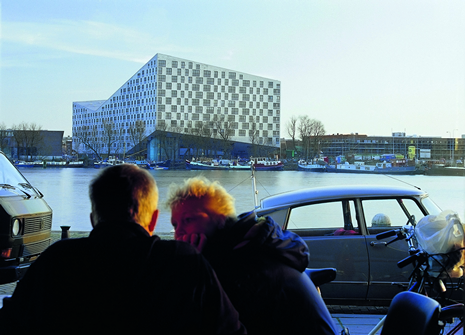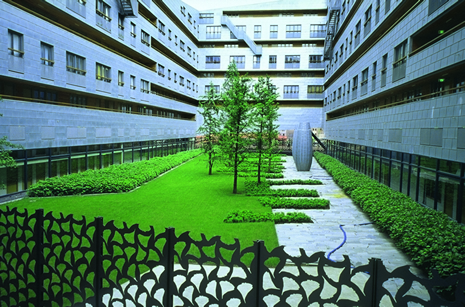Description
This project description is an excerpt from the longer article “Big Buildings”. For a comparative analysis and further data on this and all other categories including accompanying graphs, please see the article “A Turning Point”.
Situated directly across the water from the Piraeus block is yet another striking landmark in this Eastern Harbor District – The Whale. Finished in 2000, this housing complex by de Architekten Cie is part of the Borneo-Sporenburg redevelopment that began in 1996, after the completion of KNSM-eiland. The plan called for a low-rise, high-density residential district, on the order of 100 dwelling units per hectare. The Whale is one of three large sculptural blocks or ‘meteorites’ as they were dubbed by Adriaan Geuze from West 8, that were interdicted within this low-rise milieu in the firm’s urban planning vision for the two islands. Together, they were positioned strategically to relate visually to other significant points in the surroundings, including the waterfront and the assertive presence of the Piraeus block. Of the three, only The Whale and the Pacman, located on Borneo island by Koen van Velsen, were materialized; the Fountainhead, designed by Kees Christiaanse, remains unbuilt. Comprising 150 social housing units and another 64 private apartments for rent, the silver-grey, zinc-clad project rises above a sea of brown brick row houses when viewed from afar.
[1]
Designed by West 8, the small courtyard garden continues the silver-grey piscine theme through the placement of four free-standing 18-foot-tall zinc vases along a path laid with Norwegian slate, set within a manicured lawn interspersed with several geometrically-shaped hedges and Gingko trees. Unlike the open courtyards of the Piraeus, this enclosure at The Whale is only visually accessible, meant clearly for viewing and contemplation rather than for occupation and interaction. The ground floor of the project is lined with commercial premises, distinguished from the residential apartments above with their floor-to-ceiling glazed façades. Access to the apartments is limited to the two glass stairways at the base of the building’s lifted corners, connected by L-shaped, or straight, horizontal galleries that alternate between the even- and the odd-numbered floors, and every other floor is linked by a secondary system of stairs grafted to the exterior of the building within the courtyard. These galleries and railings are covered in warm larch wood, contrasting with the cool, metallic finish of the external fenestration with its uniform bands of windows that alternate every other floor. In terms of unit variation, The Whale has a smaller range compared to the Piraeus block, with several standard plans that line the center of each side, and the corners as well as the top levels under the sloped roof and soffit planes occupied by deviations from the norm, including larger units and duplexes. The units are generally divided length-wise in their spatial organization into a living axis as well as a secondary service axis; the bathrooms are typically located in the center of the units, with the kitchen adjacent or right across an internal corridor. Each unit is dual aspect and no more than 14 meters deep, offering views to both the courtyard and the surroundings but also returning again to the fundamental design principle of bringing plenty of light into dwellings. While it does not share the same degree of unit diversity as the Piraeus block, The Whale does accommodate an even higher residential density of 428 dwelling units per hectare.
Footnotes
“‘The Whale’ residential complex, Amsterdam”, Cie, accessed November 2, 2013, http://www1.cie.nl/projects/projects/residential/the-whale,-amsterdam.aspx
Drawings
Axonometric site plan of KNSM Eiland and Borneo-Sporenburg
Sectional perspective of building within its specific urban context
Site plan, scale 1:5000
Site plan illustrating the building’s contextual connectivity
Standard floor, scale 1:2000
Cross section showing usage distribution, scale 1:2000
Residential unit types and distribution, scale 1:500
Photos

Exterior view

View of courtyard
Originally published in: Peter G. Rowe, Har Ye Kan, Urban Intensities: Contemporary Housing Types and Territories, Birkhäuser, 2014.